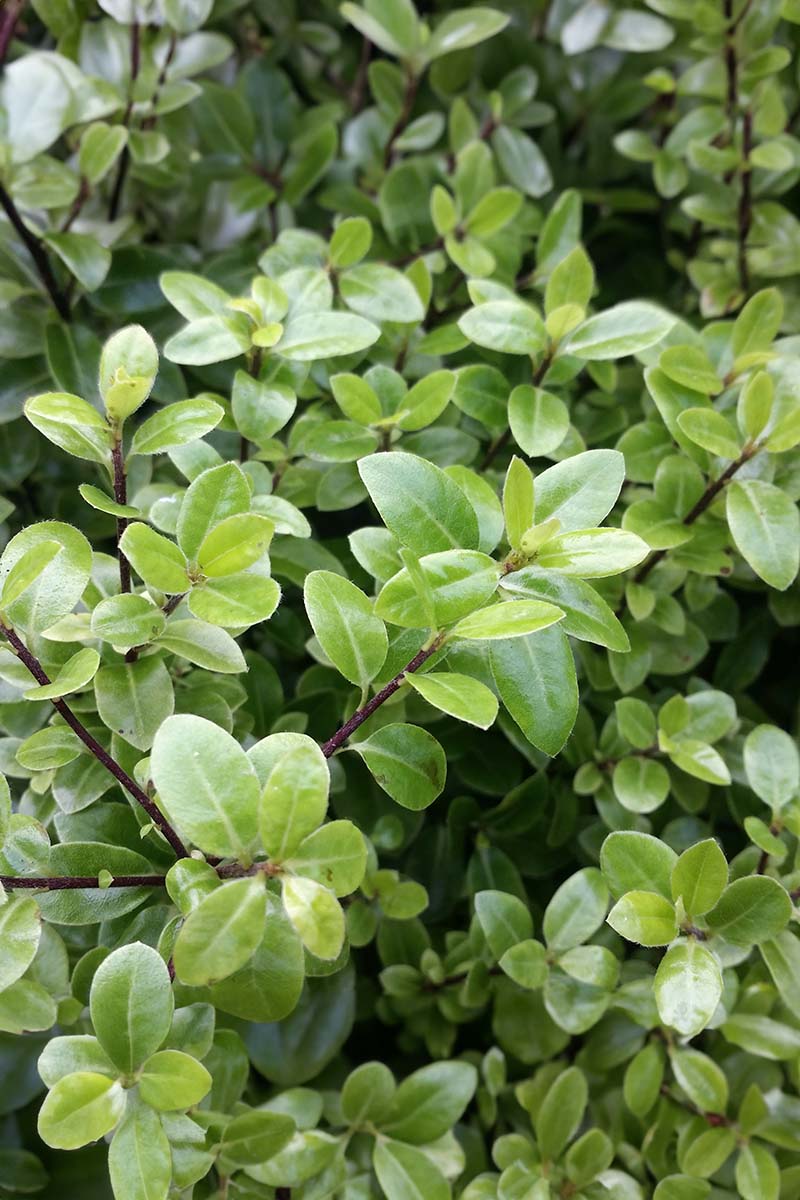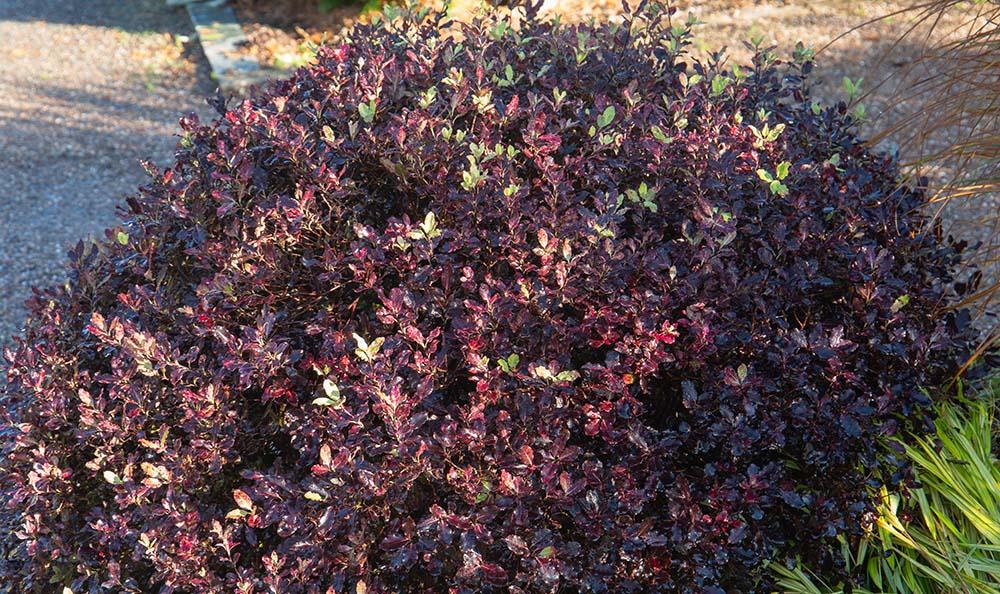Plant Focus: Pittosporum tenuifolium
A useful evergreen species for year-round structure
Pittosporum tenuifolium is one of around 200 species of flowering plants within the Pittosporaceae family. Native to New Zealand, within the lower mountain forests and coastal areas of the North and South islands, Pittosporum tenuifolium is known as kohuhu by the Māori people. It’s also commonly known as tawhiwhi.
Pittosporum tenuifolium is an evergreen shrub or small tree, with a bushy, upright habit that provides year-round structural interest. Its height can reach around 8m if allowed, but other varieties of this species tend to reach 1 to 4m. Useful for many different planting options, Pittosporum tenuifolium can be grown as hedging, a specimen plant, or positioned in the back of a border. It can also be clipped into various shapes, such as domes or balls.
Key Characteristics of Pittosporum tenuifolium:
✓ Evergreen shrub or small tree
✓ Height varies from 1m to 8m
✓ Year-round structural interest
✓ Flowers from late spring to early summer
✓ Useful as a specimen, for hedging, or in flower borders and beds
✓ Thrives in well-drained soils
✓ Prefers sheltered, sunny, or partially shaded spots
✓ Responds well to pruning
✓ Drought tolerant once established
Grown for its attractive foliage and dark stems, Pittosporum tenuifolium has shiny, variegated, and wavy-edged leaves in shades such as purple, yellow, green, or silver-grey. Its foliage is often used within flowering arrangements. It produces scented, nectar-rich small flowers from late spring to early summer, which are followed by black seeds. The flowers are particularly fragrant in the evening, when they give off a lovely honey scent. This fragrance is enhanced during slightly damp conditions.
Although Pittosporum tenuifolium is hardy in most parts of the UK, it may need protection during winter in colder areas. A sheltered position is ideal, against a south or west-facing wall, to protect from frost damage. It generally prefers sunny or partially shaded, sheltered spots, and will develop the best leaf colour in full sun. Pittosporum tenuifolium is great for coastal locations as it can tolerate salt-laden air.
Providing nectar, Pittosporum tenuifolium is useful to a number of pollinators, including bees and butterflies. It also benefits wildlife during the winter months by providing shelter to many invertebrates, including ground beetles and ladybirds.
Fun fact – The Māori people in New Zealand use the oil from Pittosporum tenuifolium as a perfume, due to its pleasant fragrance and medicinal properties.
Our favourite Pittosporum tenuifolium varieties
Pittosporum tenuifolium ‘Elizabeth’
This evergreen shrub grows up to around 4m tall, and has grey-green narrow leaves with wavy, cream margins, which turn pink, especially in cold weather. It blooms small, sweetly scented flowers in spring and summer and is perfect for a sheltered garden or creating an informal screen.

Potentilla fruticosa ‘Goldfinger’
Pittosporum tenuifolium ‘Golf Ball’
This Pittosporum is a smaller, neat, dense, rounded shrub that grows up to around 1m tall. It is good for growing as low hedging in sunny or partially shaded areas, and rarely needs pruning. These also have sweetly scented dark purple flowers which give contrast against the light green foliage.

Potentilla fruticosa ‘Goldfinger’

Pittosporum tenuifolium ‘Irene Paterson’ – Image via Flickr by Leonora (Ellie) Enking.

Pittosporum tenuifolium ‘Silver Queen’
Pittosporum tenuifolium ‘Irene Paterson’
Similar to Pittosporum tenuifolium ‘Golf Ball’, this is a low growing shrub that grows up to around 1m in height. It has silvery green variegated foliage which flushes pink in winter, and has small, purple, contrasting flowers. It is ideal for planting in a border or as a low hedge.
Pittosporum tenuifolium ‘Silver Queen’
This bushy evergreen shrub has grey-green leaves with thin, cream margins, so even though it only flowers between May and June, it is an attractive shrub all year round. It grows to around 1.5m tall so is also useful as a low hedge in full sun or partial shade.
Pittosporum tenuifolium ‘Tom Thumb’
This is a compact, versatile evergreen shrub that grows to around 1m in height and is perfect for planting in beds and borders. Its leaves are small and have wavy margins, but are different to other Pittosporum varieties, being dark purple in colour. It’s ideal for planting in city, coastal, or cottage gardens and can contrast nicely with surrounding plants.

Pittosporum tenuifolium ‘Tom Thumb’
Pittosporum tenuifolium ‘Variegatum’
Pittosporum tenuifolium ‘Variegatum’ features small, oval-shaped grey-green leaves with white margins, and can grow up to 4m tall. It is best planted in a sheltered spot in well-drained soil as they often need protection during winter. It also has dark purple flowers, similar to the other Pittosporum varieties mentioned.
How to grow Pittosporum tenuifolium
Container grown Pittosporum tenuifolium can be planted all year round, but spring and autumn are preferable as the soil is moist and warm during these seasons. It thrives in sheltered positions, in full sun or light shade, and varieties with variegated leaves should be positioned in full sun to enhance their foliage colour. Tolerating many different soil types, Pittosporum tenuifolium grows well in neutral, acidic, and alkaline soils, as long as they are well-drained. They struggle in cold, exposed locations, or in wet soil.
To prepare the planting area, combine organic matter within the soil to enhance its moisture retention capability and improve drainage. Once you have planted your Pittosporum tenuifolium, mulch the plant with organic matter to further help retain moisture, whilst ensuring to leave a mulch-free circle around the base of the plant to prevent rotting.

Pittosporum tenuifolium ‘Tom Thumb’

Pittosporum tenuifolium ‘Variegatum’
How to care for Pittosporum tenuifolium
Once you’ve planted your Pittosporum tenuifolium, it’s important to water it regularly during dry spells in spring and summer, as its roots are still establishing at this point. If you’ve planted in summer, keep the soil damp by watering more regularly. Thankfully, once established it is fairly drought tolerant. If you’re planting a mature Pittosporum tenuifolium, it can take up to five years to establish, so will need to be regularly watered for a longer period of time.
If your Pittosporum tenuifolium is planted within a border, it shouldn’t require plant feed. However, if it’s not looking its best, we recommend using a general fertiliser in spring. If it has become frost damaged over winter, feed it in early spring to help it to recover. Responding well to pruning, Pittosporum tenuifolium can easily be kept more compact in size if this is your preference. If your shrub is overgrown, you can hard prune during spring, but it’s best to avoid pruning older wood. You can encourage new growth by using a general fertiliser after pruning. If your Pittosporum tenuifolium has been grown as hedging, it can be pruned from mid spring to late summer, and can be trimmed around two to three times during its growing season to keep its even, neat shape. With specimens, these can be pruned in mid spring to help enhance its shape and keep the central stem nice and strong. Any winter damaged shoots can also be trimmed at this point.
Which pests and diseases can Pittosporum tenuifolium be affected by?
Pittosporum tenuifolium generally doesn’t suffer from pests and diseases. However, it’s good to be on the lookout for powdery mildew, aphids, and leaf spot. Powdery mildew is a fungal disease; it causes dusty, white, cobweb-like patches above leaves and flowers. Unfortunately, it weakens the plant and can spread incredibly quickly. The best way to treat this is using biological fungicides.
Aphids are a parasitic insect which suck the sap from ornamental plants and cover it with a sugary substance, called honeydew. This suffocates the leaves and attracts harmful fungi and insects. Foliage can become misshapen, curling, wilted, yellow or stunted, and a sticky substance often develops on them. Usually, aphids can be controlled and eliminated by their natural predators. However, if this is not the case, biological products, such as macerated garlic, can be useful treatment methods.
Leaf spot is a broad concept for many different fungal or bacterial diseases. It usually causes black or brown patches with dark margins on leaves. Eventually, the whole leaf dies and falls off, resulting in stunted growth and impaired aesthetic appearance. Leaf spot can be treated by using an organic solution containing sulphur or copper octanoate.
If you’d like more information about the Pittosporum tenuifolium varieties which we grow and supply, get in touch with the G Team today.

